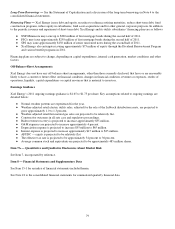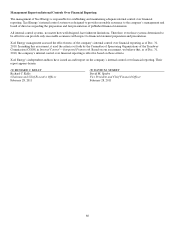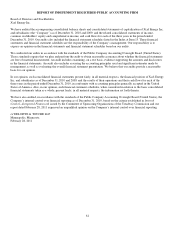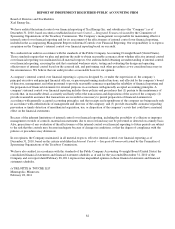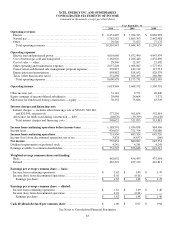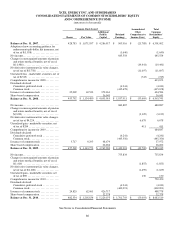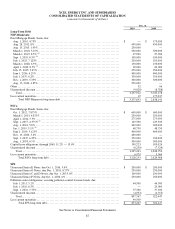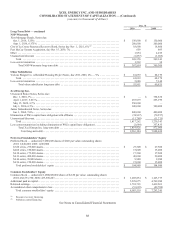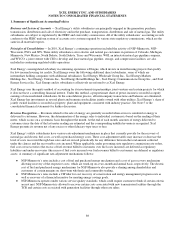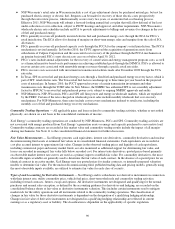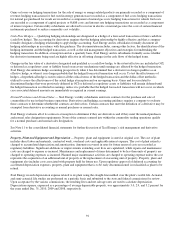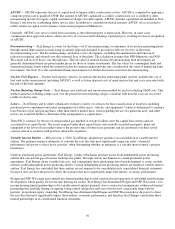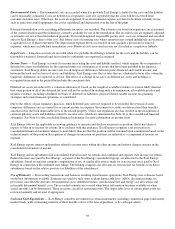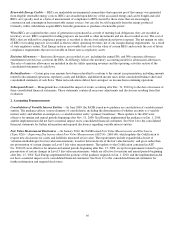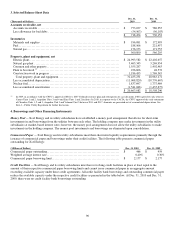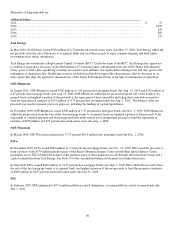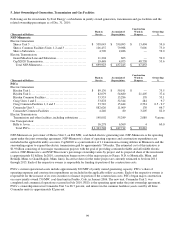Xcel Energy 2010 Annual Report Download - page 99
Download and view the complete annual report
Please find page 99 of the 2010 Xcel Energy annual report below. You can navigate through the pages in the report by either clicking on the pages listed below, or by using the keyword search tool below to find specific information within the annual report.89
XCEL ENERGY INC. AND SUBSIDIARIES
NOTES TO CONSOLIDATED FINANCIAL STATEMENTS
1. Summary of Significant Accounting Policies
Business and System of Accounts — Xcel Energy’s utility subsidiaries are principally engaged in the generation, purchase,
transmission, distribution and sale of electricity and in the purchase, transportation, distribution and sale of natural gas. The utility
subsidiaries are subject to regulation by the FERC and state utility commissions. All of the utility subsidiaries’ accounting records
conform to the FERC uniform system of accounts or to systems required by various state regulatory commissions, which are the
same in all material respects.
Principles of Consolidation — In 2010, Xcel Energy’s continuing operations included the activity of NSP-Minnesota, NSP-
Wisconsin, PSCo and SPS. These utility subsidiaries serve electric and natural gas customers in portions of Colorado, Michigan,
Minnesota, New Mexico, North Dakota, South Dakota, Texas and Wisconsin. WGI, an interstate natural gas pipeline company,
and WYCO, a joint venture with CIG to develop and lease natural gas pipeline, storage, and compression facilities, are also
included in continuing regulated utility operations.
Xcel Energy’s nonregulated subsidiary in continuing operations is Eloigne, which invests in rental housing projects that qualify
for low-income housing tax credits. Xcel Energy owns the following additional direct subsidiaries, some of which are
intermediate holding companies with additional subsidiaries: Xcel Energy Wholesale Group Inc., Xcel Energy Markets
Holdings Inc., Xcel Energy Ventures Inc., Xcel Energy Retail Holdings Inc., Xcel Energy Communications Group Inc., and Xcel
Energy Services Inc. Xcel Energy and its subsidiaries collectively are referred to as Xcel Energy.
Xcel Energy uses the equity method of accounting for its investments in partnerships, joint ventures and certain projects for which
it does not have a controlling financial interest. Under this method, a proportionate share of pretax income is recorded as equity
earnings of unconsolidated subsidiaries. In the consolidation process, all intercompany transactions and balances are eliminated.
Xcel Energy has investments in several plants and transmission facilities jointly owned with other utilities. Xcel Energy’s share of
jointly owned facilities is recorded as property, plant and equipment, consistent with industry practice. See Note 5 to the
consolidated financial statements for further discussion.
Revenue Recognition — Revenues related to the sale of energy are generally recorded when service is rendered or energy is
delivered to customers. However, the determination of the energy sales to individual customers is based on the reading of their
meter, which occurs on a systematic basis throughout the month. At the end of each month, amounts of energy delivered to
customers since the date of the last meter reading are estimated and the corresponding unbilled revenue is recognized. Xcel
Energy presents its revenue net of any excise or other fiduciary-type taxes or fees.
Xcel Energy’s utility subsidiaries have various rate-adjustment mechanisms in place that currently provide for the recovery of
natural gas and electric fuel costs, as well as purchased energy costs. These cost-adjustment tariffs may increase or decrease the
level of costs recovered through base rates and are revised periodically for any difference between the total amount collected
under the clauses and the recoverable costs incurred. Where applicable, under governing state regulatory commission rate orders,
fuel cost over-recoveries (the excess of fuel revenue billed to customers over fuel costs incurred) are deferred as regulatory
liabilities and under-recoveries (the excess of fuel costs incurred over fuel revenues billed to customers) are deferred as regulatory
assets. A summary of significant rate-adjustment mechanisms follows:
● NSP-Minnesota’s rates include a cost of fuel and purchased energy mechanism and a cost of gas recovery mechanism
allowing recovery of the respective costs, which are trued-up on a two-month and annual basis, respectively. The electric
cost of fuel and purchased energy mechanisms for NSP-Minnesota also provide a sharing among shareholders and
customers of certain margins on short-term wholesale and commodity trading.
● NSP-Minnesota’s rates include a CIP rider for cost recovery of conservation and energy management program costs as
well as recovery of a financial incentive for meeting energy savings goals.
● NSP-Minnesota operates under various service quality standards, which could require customer refunds if certain criteria
are not met. NSP-Minnesota is allowed to recover certain costs associated with new transmission facilities through the
TCR and certain costs associated with generation facilities through other rate riders.


